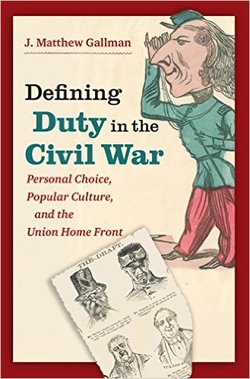
J. Matthew Gallman
University of North Carolina Press, 2015, 336 pp., $45
ISBN: 978-1-44696-20992
Image courtesy of amazon.com
When we think of the newspapers and the overall print media during the American Civil War, the first thoughts we have tend to stray towards Harper’s Weekly and the constant flow of reporters and artists who came from it. However, in Defining Duty in the Civil War, J. Matthew Gallman takes a look into the world of how the print media created a sense of patriotism on the home front for the Union. Not only does he look at the over newspaper stories, he observes satirical cartoons, stories, and even some songs which would give way to some truly great American music. Defining Duty in the Civil War also tackles the subject of supporting the cause without fighting for the cause which is rarely observed in any volume of Civil War academia.
J. Matthew Gallman is a professor of history at the University of Florida and received his bachelors at Princeton and his Ph.D. at Brandeis University. He has also taught at Gettysburg College. He has written Receiving Erin’s Children: Philadelphia, Liverpool, and the Irish Famine Migration, 1845-1855. This book is also part of the University of North Carolina Press’ Civil War America series.
Defining Duty in the Civil War is an incredibly different study and the breadth of this work is noticeable from the first page. The issues which he speaks of not only give the reader a better idea of the home front, but almost an ideal of what spoke to them. One of the most profound sections of this book dealt with the men who were patriotic, but chose to defend the home front instead of going onto the field. Gallman mentions that northern society wholly embraced the Union soldier with many portraits and representations of not only the “hero,” but of the fallen hero as well. He goes on to explain some of the prevalent political cartoons concerning the men who were defending their home who were more fortunate than those who were off at war. He handles the subject of the Home Guard in ways I have not read before and with a plethora of political cartoons and images within his work, it is clear what his message is in these pages. After looking up some information about Mr. Gallman, I noticed that he taught American Women’s History for undergraduate students. His chapter dealing with the women of the Union home front was excellent. While many are familiar with writers such as Louisa May Alcott and Harriet Beecher Stowe, Gallman highlights some of the other women who took the press to heighten patriotism on the home front. Some of the stories written by these ladies showcased many different ideals of life at home. He talks about one particular story where a woman is frustrated while looking for money or yarn for her “soldier’s sewing circle.” Her brother is in uniform and her fiancé is about to leave for war and this character must do what she can to help. Gallman tells us that it is the sign of great volunteerism while pointing out those who did not want to help. Stories such as this not only vaulted women to aid in the wartime ventures, but also did quite a bit to shame those who did nothing as well.
I highly recommend this book to anyone interested in the American Civil War. I say that because this book handles some of the issues of the home front unlike any book I have read before. We read quite a bit about the home front of the south, but overall, the north tends to be ignored. I praise Gallman for what he has written here and hope that many others see the value of this work. His research is phenomenal, his writing is engaging, and the reader is never left confused. Another fine addition to the Civil War America series.
 RSS Feed
RSS Feed
